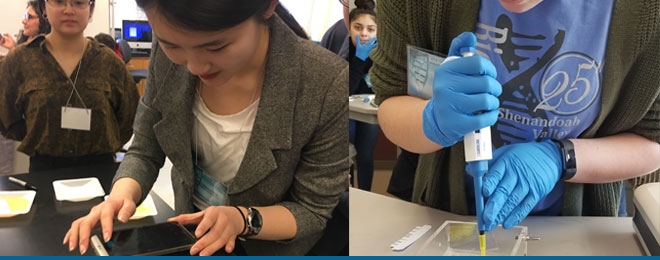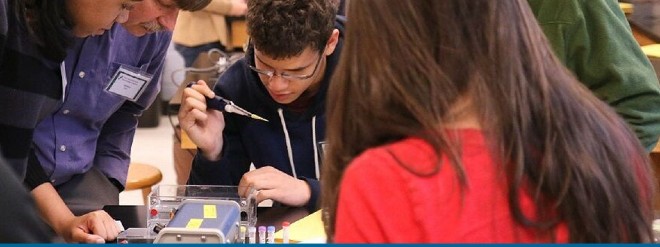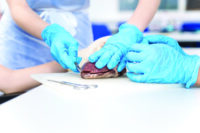A Carolina Case Study
FAST FACTS
Interviewees
Mr. Myron Blosser,
Harrisonburg High School, Harrisonburg, Virginia
Professor Ken Roth,
Blue Ridge Community College, Flat Rock, North Carolina
Professor Tim Bloss,
James Madison University, Harrisonburg, Virginia
Challenge
Providing students with hands-on experience in biotechnology techniques while saving busy teachers precious time.
Solution
Carolina® Biotechnology Lab Kits
Results
Students get hands-on experience with real-world biotechnology topics and techniques, and teachers spend more time with their students rather than prepping and troubleshooting.
Contact
Carolina Biological Supply Company
Carolina® Biotechnology Lab Kits Shine at the Shenandoah Valley Biotechnology Symposium
Mr. Blosser, a biology teacher at Harrisonburg High School in Virginia, asked Carolina to help him that first year by providing lab kits and teaching the attendees–including himself–how to use the newly emerging techniques and equipment. Blosser was astounded at the enthusiastic response from the teachers, several of whom called the following year to ask when the next symposium would be held! Thus began the annual event and the strong commitment forged between Blosser and Carolina to continue to provide high-caliber biotechnology experiences to students and teachers.
Each Symposium has a keynote speaker from the scientific community that focuses on a specific biotechnology topic. Past speakers have included Dr. Francis Collins, Director of the National Institutes of Health (NIH), and Dr. Dave Micklos, Director of the DNA Learning Center at Cold Spring Harbor Laboratory. These prominent scientists have discussed current biotechnology topics, including gene therapy and biodegradable plastics. Following the keynote address, the students break into lab groups to conduct a biotechnology investigation under the direction of local college professors.
Carolina’s biotechnology lab kits are a key contributor to the success of the symposium. Mr. Blosser has realized many benefits from the kits as a teacher and has heard the same from teacher attendees. He has also enjoyed seeing his students and those at the symposium become fully engaged and enthusiastic as they conduct their own biotechnology investigation.
The Carolina® biotechnology lab kits enable me to provide my students with cutting-edge techniques and research abilities, and share the same [techniques and abilities] with teachers in the Shenandoah Valley
Myron Blosser, Biology Teacher, Harrisonburg High School, Harrisonburg, Virginia

Easy Prep and Implementation
Teachers need tools that help them use their time efficiently while also enriching their students’ learning experience. The Carolina® biotechnology kits include all of the materials needed for the investigation, materials that are “well-designed and high-quality” as described by the symposium lab instructors. Teachers find the kits well-organized and the instructions clearly and logically presented. This makes lab setup and completion easy, allowing teachers to spend valuable time with their students as they conduct their investigation. Professor Ken Roth, one of the symposium lab instructors, expresses his appreciation for the lab kits: “Without the kits, teachers would have a lot of front-end work to get a biotechnology lab like this planned, set up, and off the ground.”
Versatility is another benefit of the biotechnology kits that teachers enjoy. Mr. Blosser and the symposium participants have seen first-hand how the biotechnology kits can be adapted for different real-life scenarios. For example, over the years the symposium has used DNA gel electrophoresis kits to explore molecular forensics, biomarkers of colon cancer susceptibility, lambda virus genome mapping, and other applications.
Without the kits, teachers would have a lot of front-end work to get a biotechnology lab like this planned, set up, and off the ground.
Professor Ken Roth, Blue Ridge Community College, Flat Rock, North Carolina

Student Engagement and Success
The symposium students are quickly drawn into the investigation they are conducting, and their confidence grows as they successfully complete each step. “The instructions are clear and easy to follow,” explains Professor Tim Bloss, “so even students who are new to hands-on science labs are successful.” The kits are designed to make it easy for students to follow the investigation workflow–for example, using color-coding to tie together a specific step of the protocol with the materials involved in that step. Such simple but effective features help students accurately follow the instructions and avoid making disheartening mistakes.
The kits enable students to complete a complex protocol in a short period of time, which helps maintain their attention and interest. The labs generate “straightforward data that students can understand, analyze, and report accurately,” describes Mr. Blosser. The data analysis instructions lead the students to really think about the data they generated, what conclusions they can draw from the results, and how best to present the data and their conclusions in their lab report. The completeness of the kit and the straightforward instructions allow teachers more time to interact with their students during the data evaluation stage of their investigation.
The new GelGreen® works really well, is fast and reliable, and presents the results clearly
Professor Tim Bloss, James Madison University, Harrisonburg, Virginia
Continuous Innovation and Expertise
The lab kits used at the symposium have evolved over the last 26 years, both in their topic focus and experimental techniques. Mr. Blosser appreciates that Carolina is “continuously looking to improve the kit materials and protocols to make the labs easier, better, and faster.” GelGreen® was used at the 2019 symposium with outstanding results. GelGreen® is used to stain the electrophoresis gel, but unlike other stains, it does not require de-staining followed by re-staining to produce observable results. Paired with Carolina® GelView, results are visualized using safer blue LED illumination, rather than an ultraviolet apparatus required by other stains. “The new GelGreen® works really well,” reports Professor Bloss, “is fast and reliable, and presents the results clearly.”




